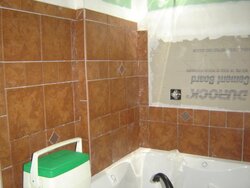Executive Summary: tile install in new bathroom may need some serious reworks.
Building a new bathroom in my 124 yr old Victorian. 60x60 Jacuzzi in the corner w/ an alcove return and shower in it. I'm doing all the design, electrical, framing, and tile work for this renovation, but vended out the plumbing (entire house replumbed as part of this effort) and sheetrock, because of the amount of work involved in getting the rock there, hanging it quickly, etc.
Sheetrock guy hung 1/2" greenboard and Durock, but appears to have used plain paper joint tape and drywall mud to joint it all. And ran the Durock right down tight onto the top of the tub face.
My architect friend says he should have used mesh tape, durabond to joint it, and left about a 1/4" gap from the top of the tub face, which I should have then packed w/ Phenoseal vinyl adhesive caulk. He's worried that the paper and mud products on the back, especially down at the tub/tile joint, will wind up exposed to even a pinhole leak, and will wick moisture up into the walls like crazy, inviting mold, rot, and tile failure.
And to compound issues, I spent all day yesterday cutting tile (new tile saw is suh-WEET!) and then installing the bottom course. I left it mostly tight down against the tub face. Tile is all 3/8"+ thickness terra cotta (bulletproof for sure). Bottom course of tile is all 12x12's, so my thinking is I could run a fat radius bead of Phenoseal along the vertical corners and the horizontal tub/tile joint, and pack the 12" vertical grout lines between the bottom tiles w/ phenoseal too (instead of grout). And so long as I get a Phenoseal and grout to match each other, it'll be waterproof and mostly undetectable.
Tile on the bare joint compound was a concern but feels like it's going to hold at least marginally well. The field is all on bare Durock, and that is definitely not going to have any bond issues. I'm using a premixed adhesive from Lowes that the (IMO) fairly knowledgeable sales guy recommended.
Other options include ripping out all the tile that sits on joint compound, sanding down that compound, dig out the tub/Durock horizontal joint to make a 1/4" gap (which will wind up ugly and I risk murdering the tub finish) replace the corner tape w/ mesh, and refinish all the joints and edges w/ Durabond. Then knock the scabbed-on mastic off the back of the cut tiles, and re-lay those tiles w/ new mastic over the Durabond.
Or rip out everything, and replace the Durock, which I REALLY don't wanna do.
ARRRRGH. I can see this consuming every waking moment for the next two weeks. Any thoughts from more experienced folks here??
Building a new bathroom in my 124 yr old Victorian. 60x60 Jacuzzi in the corner w/ an alcove return and shower in it. I'm doing all the design, electrical, framing, and tile work for this renovation, but vended out the plumbing (entire house replumbed as part of this effort) and sheetrock, because of the amount of work involved in getting the rock there, hanging it quickly, etc.
Sheetrock guy hung 1/2" greenboard and Durock, but appears to have used plain paper joint tape and drywall mud to joint it all. And ran the Durock right down tight onto the top of the tub face.
My architect friend says he should have used mesh tape, durabond to joint it, and left about a 1/4" gap from the top of the tub face, which I should have then packed w/ Phenoseal vinyl adhesive caulk. He's worried that the paper and mud products on the back, especially down at the tub/tile joint, will wind up exposed to even a pinhole leak, and will wick moisture up into the walls like crazy, inviting mold, rot, and tile failure.
And to compound issues, I spent all day yesterday cutting tile (new tile saw is suh-WEET!) and then installing the bottom course. I left it mostly tight down against the tub face. Tile is all 3/8"+ thickness terra cotta (bulletproof for sure). Bottom course of tile is all 12x12's, so my thinking is I could run a fat radius bead of Phenoseal along the vertical corners and the horizontal tub/tile joint, and pack the 12" vertical grout lines between the bottom tiles w/ phenoseal too (instead of grout). And so long as I get a Phenoseal and grout to match each other, it'll be waterproof and mostly undetectable.
Tile on the bare joint compound was a concern but feels like it's going to hold at least marginally well. The field is all on bare Durock, and that is definitely not going to have any bond issues. I'm using a premixed adhesive from Lowes that the (IMO) fairly knowledgeable sales guy recommended.
Other options include ripping out all the tile that sits on joint compound, sanding down that compound, dig out the tub/Durock horizontal joint to make a 1/4" gap (which will wind up ugly and I risk murdering the tub finish) replace the corner tape w/ mesh, and refinish all the joints and edges w/ Durabond. Then knock the scabbed-on mastic off the back of the cut tiles, and re-lay those tiles w/ new mastic over the Durabond.
Or rip out everything, and replace the Durock, which I REALLY don't wanna do.
ARRRRGH. I can see this consuming every waking moment for the next two weeks. Any thoughts from more experienced folks here??



